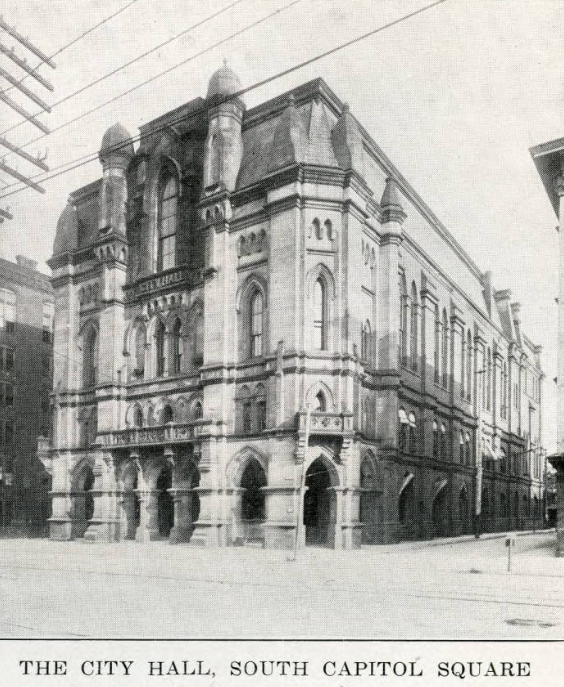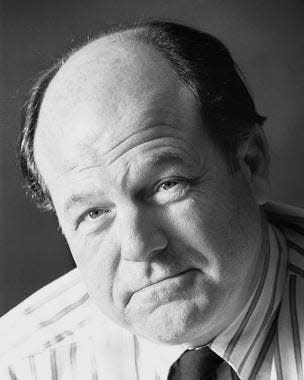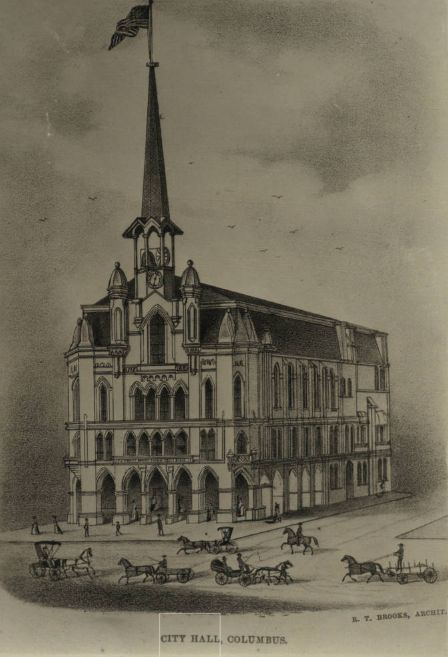Columbus' first stand-alone City Hall was originally a beautiful and imposing building

Being a created city does have more than a few disadvantages. Some of these issues for Columbus included the threat of fire, flood and attack by people who did not like the settlers all that much. Less harmful, but not the least of these problems, was finding a place for local government, such as it was, to take place.
There had been no town or village on the “High Banks opposite Franklinton at the Forks of the Scioto” after the Mound Builders and other Native Americans had left the site.
The new town of Columbus, founded on February 14, 1812, soon found its growth impeded by the coming of the War of 1812. Despite the war, the proprietors of the new town soon saw the construction of a new state penitentiary where the Priscilla R. Tyson Cultural Arts Center is today at 139 W. Main St. Prisoners from the “pen” soon were helping local contractors build a new Statehouse, a state office building and a state Supreme Court building all on the southwest corner of Statehouse Square.
By the fall of 1816, the War of 1812 was over and the Ohio General Assembly came to Columbus for its first meeting. The town the General Assembly came to had recently been incorporated as the Borough of Columbus and a new City Council headed by Mayor Jarvis Pike met the legislators.

Through the next several years, progress was made and the town increased slowly in size. Then the Ohio Canal and the National Road arrived in 1831. In two years, Columbus saw its population grow from 2,000 to 5, 000 people.
During these years, Columbus had never really had a place for its local government to call home. The City Council held its first meeting at the Columbus Inn. Its second meeting was at the home of one of its members. And so it went, as the council met at local taverns, marketplaces and private residences over the years.
It was not until 1850 that Columbus city government found a home of its own atop a new Central Market located immediately southeast of Statehouse Square. The first floor of the new block-long market was occupied by stalls selling everything from baked goods and vegetables to live chickens. The second floor had offices for local officials and a large city council chamber which also served as a local courtroom. A two-story brick jail or "calaboose" was located next door and prisoners could walk directly from the council chamber/ courtoom to a jail cell. All of this served the city reasonably well, but the city was continuing to grow rather rapidly.
More: North Market is oldest survivor among Columbus' public markets that date back to 1814
By the time of the Civil War, Columbus was a town of 18,000. With the opening of railroad lines serving the coal fields of southeast Ohio, Columbus was a town of a bout 30,000 in the late 1860s. Tired of competing with rather loud chickens under their feet, Columbus leaders convinced their residents that a new city hall was needed.
A site on the southeast corner of State Street and Pearl Alley and running to Town Street was selected. Work began on the new building in May 1869.
Designed by architect Robert T. Brookes (who also designed Towers Hall at Otterbein University and was the final architect for St. Joseph Cathedral in Columbus), the new city hall was French Second Empire in style, and large enough to encompass most of the functions of the government of the City of Columbus then spread across the town in rented buildings.
A local history written at the time described the new city hall in some detail: “The building is 187 ½ feet long and 80 feet in width and 98 feet in height from the ground to the roof.” An elaborate clock tower was planned for the front of the building and was shown that way in an early published sketch. But it was soon determined that the barrel roof of the building could not support the tower. The tower was never built.

Nevertheless, the new three-story building was still rather impressive, based on a local historical account.
“The main entrance is at the north side of the building, beneath seven lancet archways … the upper tier of windows is lancet headed.
“On the opposite side of the central lobby is the library room 110 feet long by 28 feet wide … The Council Chamber is 59 feet long by 40 feet wide and 27 feet high …The walls are frescoed with water colors, and the flow within the bar, is covered with a handsome carpet of brilliant colors.
“The grand opening of the new City Hall to public use took place on the evening of March 28, 1872 … The festivities of the evening were on a large scale; and the event will be long remembered as one of the greatest in the annals of Columbus.”
The building's public Library Room — forerunner of the Columbus Metropolitan Library — opened in 1873.
City Hall was once described as “one of the most beautiful and imposing public edifices that adorn the capital Ohio.”
The original stand-alone City Hall served the needs Columbus quite well for many years, but was in need of both repair and restoration by the 19-teens. That work was never done, and the building's roof and interior were destroyed by fire on Jan. 12, 1921, leaving only the exterior walls.
James Thurber, who later became best known for his cartoons and his humorist writings, was covering a City Council meeting for The Dispatch on the second floor when the fire broke out and was among about 100 people who evacuated the building.
A Dispatch story shortly after the fire's carnage said the building had been deteriorating for some time and was "long an eyesore to Columbus."
City officials to decide to construct a new City Hall closer to the Scioto River in the Civic Center area.
The new City Hall opened in 1928 — the same year the The Ohio Theatre opened on the old City Hall site.
This article originally appeared on The Columbus Dispatch: After 20+ years atop Central Market, Columbus got a city hall in 1872
